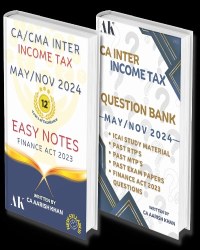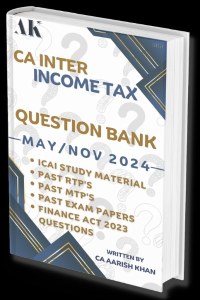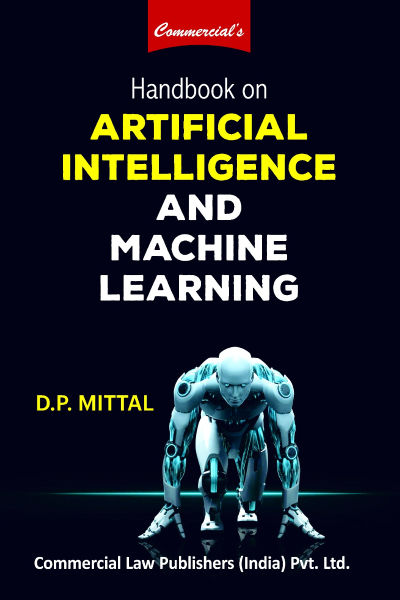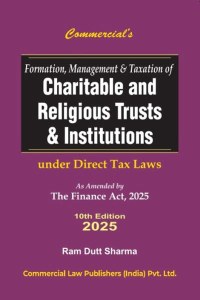Handbook on Artificial Intelligence & Machine Learning
by D.P. MittalCONTENTS
| Chapter 1: Artificial Intelligence | |
| 1.1 Introduction | 1 |
| 1.2 Artificial intelligence – An idea | 3 |
| 1.3 Artificial Intelligence (AI) performing tasks requiring human intelligence | 3 |
| 1.4 “Artificial intelligence“- nomenclature misnomer | 5 |
| 1.5 Artificial intelligence - cause for both concern and optimism | 7 |
| 1.6 Artificial intelligence and e-commerce | 9 |
| 1.7 Artificial intelligence- Part of daily life | 11 |
| 1.8 Artificial intelligence needs to be regulated | 12 |
| Chapter 2: What is Artificial Intelligence | |
| 2.1 Introduction | 15 |
| 2.2 What is artificial intelligence | 17 |
| 2.3 Artificial intelligence— kinds | 21 |
| 2.4 Artificial intelligence - Generative vs Predictive | 22 |
| 2.5 Application - Speech recognition and computer vision, etc | 23 |
|
23 |
|
23 |
|
24 |
| Voice assistants | 24 |
| True conversations with virtual assistants©Shutterstock/Zapp2Photo | 25 |
|
25 |
|
25 |
|
26 |
| 2.6 Artificial intelligence – History and development | 26 |
|
28 |
| 2.7 Artificial intelligence - Ubiquity in Technology | 29 |
| 2.8 Artificial Intelligence – Role in Market and Industry | 31 |
|
33 |
|
35 |
|
36 |
|
36 |
|
37 |
|
37 |
|
38 |
|
38 |
|
39 |
|
40 |
|
41 |
|
41 |
|
41 |
|
42 |
|
42 |
|
42 |
|
42 |
|
43 |
| 2.9 Application | 44 |
| 2.10 Limitations | 45 |
|
47 |
| 2.11 Risks and harm | 50 |
| Chapter 3: Algorithm, Data and Data Processing | |
| 3.1 Introduction | 53 |
| 3.2 Data | 53 |
|
55 |
|
55 |
|
56 |
|
57 |
|
58 |
|
59 |
|
59 |
| 3.3 Computer functions and computer software | 60 |
|
62 |
|
63 |
|
64 |
|
65 |
| 3.4 Algorithm | 66 |
| 3.5 Artificial intelligence (AI) is naught but algorithms | 67 |
| 3.6 Algorithms - heart of machine learning | 68 |
| 3.7 Algorithms and ethics | 68 |
|
69 |
|
70 |
|
71 |
| Chapter 4: Machine Learning, Deep Learning and Deepfake | |
| 4.1 Introduction | 72 |
| 4.2 Machine Learning | 73 |
|
74 |
| 4.3 AI vs ML | 75 |
| 4.4 Machine learning- kinds | 76 |
|
77 |
|
80 |
|
81 |
|
81 |
| 4.5 Machine learning- Challenges | 82 |
| 4.6 Machine learning is evolving | 83 |
| 4.7 Deep learning | 83 |
|
84 |
|
86 |
|
87 |
|
87 |
|
89 |
| 4.8 Neural network | 89 |
| Interpreting brain signals | 90 |
|
|
| 4.9 Deepfake Technology | 91 |
|
93 |
|
93 |
|
94 |
| Chapter 5: Generative Artificial Intelligence | |
| 5.1 Introduction | 96 |
| 5.2 Generative AI models / Predictive AI models | 97 |
| 5.3 Generative AI - meaning | 98 |
|
99 |
| 5.4 Generative AI- A brief history | 100 |
| 5.5 Rise of Generative Models | 102 |
| 5.6 Generative Models - Kinds | 103 |
|
104 |
|
104 |
|
105 |
|
105 |
|
107 |
|
107 |
|
108 |
|
108 |
|
109 |
| 5.7 Generative AI - What can create | 109 |
|
109 |
|
110 |
|
110 |
|
110 |
|
111 |
|
111 |
|
111 |
| 5.8 Generative AI – Benefits | 112 |
| 5.9 Generative AI - challenges and risks | 113 |
| 5.10 Leading AI tools | 113 |
| Chapter 6: ChatGPT | |
| 6.1 Introduction | 115 |
| 6.2 ChatGPT— Conversational Artificial Intelligence | 116 |
| 6.3 Evolution of Digital “Avatar� | 116 |
| 6.4 ChatGPT—Predictive principle | 117 |
| 6.5 ChatGPT—How does it work? | 118 |
| 6.6 ChatGPT — How accessed | 119 |
|
120 |
| 6.7 Whether ChatGPT is reliable? | 120 |
| 6.8 ChatGPT— how people used | 121 |
| 6.9 ChatGPT- Benefits | 122 |
|
123 |
|
123 |
| 6.10 Limitations | 124 |
| 6.11 Challenges and Ethical Considerations: | 124 |
|
125 |
|
125 |
|
125 |
|
126 |
| 6.12 ChatGPT updates | 126 |
| 6.13 ChatGPT-Alternatives | 128 |
|
129 |
| Chapter 7: Cybersecurity and Cybercrimes | |
| 7.1 Introduction | 130 |
| 7.2 Cybersecurity — meaning | 131 |
| 7.3 Cybersecurity- Risk elements | 132 |
| 7.4 Physical assets | 133 |
|
134 |
|
134 |
|
135 |
| 7.5 information assets – Information on computer | 135 |
| 7.6 Cybersecurity — administrative and physical | 137 |
| 7.7 Cybersecurity — computerised information | 138 |
|
139 |
|
139 |
| 7.8 Virus incidents | 140 |
|
140 |
|
141 |
|
141 |
|
142 |
| 7.9 Unauthorised disclosure of information | 142 |
| 7.10 Denial of service | 143 |
| 7.11 Cybercrimes | 143 |
| 7.12 Cybercrime — defined | 144 |
| 7.13 Cybercrimes — Information Technology Act, 2000 | 144 |
| 7.14 Computer a target or a tool for criminal purposes | 145 |
| 7.15 Tampering computer source document | 147 |
|
148 |
|
149 |
|
150 |
| 7.16 Hacking of computer system | 150 |
| 7.17 Unauthorised access | 152 |
|
153 |
|
155 |
|
155 |
| 7.18 Unauthorised access by employees | 155 |
| 7.19 Unauthorised downloading, copying, etc | 156 |
| 7.20 Denial of access (denial of service) | 157 |
| 7.21 Computer related fraud | 158 |
| 7.22 Information theft | 159 |
| 7.23 Cheating by personation | 160 |
|
161 |
|
161 |
| 7.24 Violation of Privacy | 163 |
| 7.25 Cyber Terrorism | 164 |
| 7.26 Cybersecurity — role that AI plays | 165 |
|
166 |
|
167 |
|
167 |
| 7.27 Security measures | 167 |
| Chapter 8: European Union Artificial Intelligence Act | |
| 8.1 Introduction | 169 |
| 8.2 Explanatory memorandum - Reasons for and objectives of the proposal | 170 |
| 8.3 Aim of the Act | 174 |
| 8.4 AI applications — classifications | 174 |
| Chapter 9: Glossary | 177 |
Appendices
THE DIGITAL PERSONAL DATA PROTECTION ACT, 2023
| Chapter I: Preliminary | |
| 1. Short title and commencement | 217 |
| 2. Definitions | 217 |
| 3. Application of Act | 220 |
| Chapter II: Obligations of Data Fiduciary | |
| 4. Grounds for processing personal data | 221 |
| 5. Notice | 221 |
| 6. Consent | 222 |
| 7. Certain legitimate | 224 |
| 8. General obligations of Data Fiduciary | 225 |
| 9. Processing of personal data of children | 227 |
| 10. Additional obligations of Significant Data Fiduciary | 228 |
| Chapter III: Rights and Duties of Data Principal | |
| 11. Right to access information about personal data | 228 |
| 12. Right to correction and erasure of personal data | 229 |
| 13. Right of grievance redressal | 230 |
| 14. Right to nominate | 230 |
| 15. Duties of Data Principal | 230 |
| Chapter IV: Special Provisions | |
| 16. Processing of personal data outside India | 231 |
| 17. Exemptions | 231 |
| Chapter V: Data Protection Board of India | |
| 18. Establishment of Board | 233 |
| 19. Composition and qualifications for appointment of Chairperson and Members | 233 |
| 20. Salary, allowances payable to and term of office | 234 |
| 21. Disqualifications for appointment and continuation as Chairperson and Members of Board | 234 |
| 22. Registration by Members and filling of vacancy | 234 |
| 23. Proceedings of Board | 234 |
| 24. Officers and employees of Board | 235 |
| 25. Members and officers to be public servants | 235 |
| 26. Powers of Chairperson | 235 |
| Chapter VI: Powers, Functions and Procedure to be Followed by Board | |
| 27. Powers and functions of Board | 236 |
| 28. Procedure to be followed by Board | 237 |
| Chapter VII: Appeal and Alternate Dispute Resolution | |
| 29. Appeal to Appellate Tribunal | 238 |
| 30. Orders passed by Appellate Tribunal to be excecutable as decree | 239 |
| 31. Atternate dispute resolution | 239 |
| 32. Voluntary undertaking | 239 |
| Chapter VIII: Penalties and Adjudication | |
| 33. Penalties | 240 |
| 34. Crediting sums realised by way of penalties to Consolidated Fund of India | 240 |
| Chapter IX: Miscellaneous | |
| 35. Protection of action taken in good faith | 240 |
| 36. Power to call information | 240 |
| 37. Power of Central Government to issue directions | 240 |
| 38. Consistency with other laws | 241 |
| 39. Bar of jurisdiction | 241 |
| 40. Power to make rules | 241 |
| 41. Laying of rules and certain notifications | 243 |
| 42. Power to amend Schedule | 243 |
| 43. Power to remove difficulties | 244 |
| 44. Amendments to certain Acts | 244 |
| The Schedule | 245 |
THE INFORMATION TECHNOLOGY ACT, 2000
90. Power of State Government to make rules
| Chapter I: Preliminary | |
| 1. Short title, extent, commencement and application | 247 |
| 2. Definitions | 248 |
| Chapter II: Digital Signature and Electronic Signature | |
| 3. Authentication of electronic records | 251 |
|
251 |
| Chapter III: Electronic Governance | |
| 4. Legal recognition of electronic records | 252 |
| 5. Legal recognition of electronic signatures | 252 |
| 6. Use of electronic records and electronic signatures in government and its agencies | 252 |
|
253 |
| 7. Retention of electronic records | 253 |
|
254 |
| 8. Publication of rule, regulation, etc., in Electronic Gazette | 254 |
| 9. Sections 6, 7 and 8 not to confer right to insist document should be accepted in electronic form | 254 |
| 10. Power to make rules by Central Government in respect of electronic signature | 254 |
|
254 |
| Chapter IV: Attribution, acknowledgement and despatch of electronic records | |
| 11. Attribution of electronic records | 255 |
| 12. Acknowledgement of receipt | 255 |
| 13. Time and place of despatch and receipt of electronic record | 255 |
| Chapter V: Secure Electronic Records and Secure Electronic Signatures | |
| 14. Secure electronic record | 256 |
| 15. Secure electronic signature | 256 |
| 16. Security procedures and practices | 256 |
| Chapter VI: Regulation of Certifying Authorities | |
| 17. Appointment of Controller and other officers | 256 |
| 18. Functions of Controller | 257 |
| 19. Recognition of Foreign Certifying Authorities | 257 |
| 20. Omitted | 258 |
| 21. Licence to issue electronic signature certificates | 258 |
| 22. Application for licence | 258 |
| 23. Renewal of licence | 258 |
| 24. Procedure for grant or rejection of licence | 259 |
| 25. Suspension of licence | 259 |
| 26. Notice of suspension or revocation of licence | 259 |
| 27. Power to delegate | 260 |
| 28. Power to investigate contraventions | 260 |
| 29. Access to computers and data | 260 |
| 30. Certifying Authority to follow certain procedures | 260 |
| 31. Certifying Authority to ensure compliance of the Act, etc | 260 |
| 32. Display of licence | 260 |
| 33. Surrender of licence | 261 |
| 34. Disclosure | 261 |
| Chapter VII: Electronic Signature Certificates | |
| 35. Certifying authority to issue Electronic Signature Certificate | 261 |
| 36. Representations upon issuance of Digital Signature Certificate | 262 |
| 37. Suspension of Digital Signature Certificate | 262 |
| 38. Revocation of Digital Signature Certificate | 262 |
| 39. Notice of suspension or revocation | 263 |
| Chapter VIII: Duties of Subscribers | |
| 40. Generating key pair | 263 |
|
263 |
| 41. Acceptance of Digital Signature Certificate | 263 |
| 42. Control of private key | 264 |
| Chapter IX: Penalties, Compensation and Adjudication | |
| 43. Penalty and compensation for damage to computer, computer system, etc | 264 |
|
265 |
| 44. Penalty for failure to furnish information, return, etc | 266 |
| 45. Residuary penalty | 266 |
| 46. Power to adjudicate | 266 |
| 47. Factors to be taken into account by the adjudicating officer | 267 |
| Chapter X: Appellate Tribunal | 267 |
| 48. Establishment of Appellate Tribunal | 267 |
| 52D. Decision by majority | 269 |
| 55. Orders constituting Appellate Tribunal to be final and not to invalidate its proceedings | 269 |
| 57. Appeal to Appellate Tribunal | 270 |
| 58. Procedure and powers of the Appellate Tribunal | 270 |
| 59. Right to legal representation | 271 |
| 60. Limitation | 271 |
| 61. Civil court not to have jurisdiction | 271 |
| 62. Appeal to High Court | 271 |
| 63. Compounding of contraventions | 271 |
| 64. Recovery of penalty or compensation | 272 |
| Chapter XI: Offences | |
| 65. Tampering with computer source documents | 272 |
| 66. Computer related offences | 272 |
|
273 |
|
273 |
|
273 |
|
273 |
|
274 |
| 67. Punishment for publishing or transmitting obscene material in electronic form | 274 |
|
274 |
|
275 |
|
275 |
| 68. Power of the Controller to give directions | 275 |
| 69. Power to issue directions for interception or monitoring or decryption of any information through any computer resource | 276 |
|
276 |
|
277 |
| 70. Protected system | 277 |
|
278 |
|
278 |
| 71. Penalty for misrepresentation | 279 |
| 72. Penalty for breach of confidentiality and privacy | 279 |
|
279 |
| 73. Penalty for publishing Electronic Signature Certificate false in certain particulars | 279 |
| 74. Publication for fraudulent purpose | 279 |
| 75. Act to apply for offences or contravention committed outside India | 280 |
| 76. Confiscation | 280 |
| 77. Compensation, penalties or confiscation not to interfere with other punishment | 280 |
|
280 |
|
280 |
| 78. Power to investigate offences | 280 |
| Chapter XII: Intermediaries not to be Liable in Certain Cases | |
| 79. Exemption from liability of intermediary in certain cases | 281 |
| Chapter XIIa: Examiner of Electronic Evidence | |
| 79A. Central Government to notify Examiner of Electronic Evidence | 281 |
| Chapter XIII: Miscellaneous | |
| 80. Power of police officer and other officers to enter, search, etc | 282 |
| 81. Act to have overriding effect | 282 |
|
282 |
| 82. Controller, Deputy Controller and Assistant Controller to be public servants | 283 |
| 83. Power to give directions | 283 |
| 84. Protection of action taken in good faith | 283 |
|
283 |
|
283 |
|
283 |
| 85. Offences by companies | 283 |
| 86. Removal of difficulties | 284 |
| 87. Power of Central Government to make rules | 284 |
| 88. Constitution of Advisory Committee | 286 |
| 89. Power of Controller to make regulations | 287 |
| 288 | |
| FIRST SCHEDULE | 289 |
| SECOND SCHEDULE | 289 |
| THIRD SCHEDULE | 291 |
| FOURTH SCHEDULE | 291 |
THE INFORMATION TECHNOLOGY (CERTIFYING AUTHORITIES) RULES, 2000
| 1. Short title and commencement | 292 |
| 2. Definitions | 292 |
| 3. The manner in which information be authenticated by means of Digital Signature | 293 |
| 4. Creation of Digital Signature | 293 |
| 5. Verification of Digital Signature | 293 |
|
294 |
| 6. Standards | 294 |
| 7. Digital Signature Certificate Standard | 295 |
| 8. Licensing of Certifying Authorities | 295 |
| 9. Location of the Facilities | 297 |
| 10. Submission of Application | 297 |
| 11. Fee | 298 |
| 12. Cross Certification | 298 |
| 13. Validity of licence | 298 |
| 14. Suspension of licence | 299 |
| 15. Renewal of licence | 299 |
| 16. Issuance of licence | 299 |
| 17. Refusal of Licence | 299 |
| 18. Governing Laws | 300 |
| 19. Security Guidelines for Certifying Authorities | 300 |
| 20. Commencement of Operation by Licenced Certifying Authorities | 300 |
| 21. Requirements Prior to Cessation as Certifying Authority | 300 |
| 22. Database of Certifying Authorities | 301 |
| 23. Digital Signature Certificate | 302 |
| 24. Generation of Digital Signature Certificate | 303 |
| 25. Issue of Digital Signature Certificate | 303 |
| 26. Certificate Lifetime | 303 |
| 27. Archival of Digital Signature Certificate | 304 |
| 28. Compromise of Digital Signature Certificate | 304 |
| 29. Revocation of Digital Signature Certificate | 304 |
| 30. Fees for issue of Digital Signature Certificate | 305 |
| 31. Audit | 305 |
| 32. Auditors relationship with Certifying Authority | 306 |
| 33. Confidential Information | 306 |
| 34. Access to Confidential Information | 306 |
| Schedule I: Form for Application for Grant of Licence to be a Certifying Authority | 306 |
| Schedule II: Information Technology (It) Security Guidelines | 309 |
| Schedule III: Security Guidelines for Certifying Authorities | 326 |
| Schedule IV: | 335 |
| Form A: Application Form for Issue of Digital Certificate for Subscriber of Government and Banking Sector | 335 |
| Form B: Application Form for Issue of Digital Signature Certificate for Subscribers Other than Government and Banking Sector | 336 |
| Form C: Application Form for Issue of Digital Signature Certificate Through EkYC Based Identity Verification of Digital Signature Certificate Applicant | 337 |
| Schedule V: Glossary | 337 |
THE INFORMATION TECHNOLOGY (OTHER POWERS OF CIVIL COURT VESTED IN CYBER APPELLATE TRIBUNAL) RULES, 2003
| 1. Short title and commencement | 355 |
| 2. Definitions | 355 |
| 3. Powers of Cyber Appellate Tribunal | 355 |
THE INFORMATION TECHNOLOGY (USE OF ELECTRONIC RECORDS AND DIGITAL SIGNATURES) RULES, 2004
| 1. Short title and commencement | 356 |
| 2. Definitions | 356 |
| 3. Filing of form, application or any other document | 356 |
| 4. Issue or grant of any licence, permit, sanction or approval | 357 |
| 5. Payment and receipt of fee or charges | 357 |
THE INFORMATION TECHNOLOGY (SECURITY PROCEDURE) RULES, 2004
| 1. Short title and commencement | 358 |
| 2. Definitions | 358 |
| 3. Secure electronic record | 358 |
| 4. Secure digital signature | 358 |
THE INFORMATION TECHNOLOGY (PROCEDURE AND SAFEGUARDS FOR INTERCEPTION, MONITORING AND DECRYPTION OF INFORMATION) RULES, 2009
| 1. Short title and commencement | 360 |
| 2. Definitions | 360 |
| 3. Directions for interception or monitoring or decryption of any information | 362 |
| 4. Authorization of agency of Government | 362 |
| 5. Issue of decryption direction by competent authority | 362 |
| 6. Interception or monitoring or decryption of information by a State beyond its jurisdiction | 363 |
| 7. Contents of direction | 363 |
| 8. Competent authority to consider alternative means in acquiring information | 363 |
| 9. Direction of interception or monitoring or decryption of any specific information | 363 |
| 10. Direction to specify the name and designation of the officer to whom information to be disclosed | 363 |
| 11. Period within which direction shall remain in force | 363 |
| 12. Authorized agency to designate nodal officer | 363 |
| 13. Intermediary to provide facilities, etc | 364 |
| 14. Intermediary to designate officers to receive and handle requisition | 364 |
| 15. Acknowledgement of instruction | 364 |
| 16. Maintenance of records by designated officer | 364 |
| 17. Decryption key holder to disclose decryption key or provide decryption assistance | 364 |
| 18. Submission of list of interception or monitoring or decryption of information | 365 |
| 19. Intermediary to ensure effective check in handling matter of interception or monitoring or decryption of information | 365 |
| 20. Intermediary to ensure effective check in handling matter of interception or monitoring or decryption of information | 365 |
| 21. Responsibility of intermediary | 365 |
| 22. Review of directions of competent authority | 365 |
| 23. Destruction of records of interception or monitoring or decryption of information | 366 |
| 24. Prohibition of interception or monitoring or decryption of information without authorization | 366 |
| 25. Prohibition of disclosure of intercepted or monitored or decrypted information | 367 |
THE INFORMATION TECHNOLOGY (PROCEDURE AND SAFEGUARDS FOR BLOCKING FOR ACCESS OF INFORMATION BY PUBLIC) RULES, 2009
| 1. Short title and commencement | 368 |
| 2. Definitions | 368 |
| 3. Designated Officer | 369 |
| 4. Nodal officer of organization | 369 |
| 5. Direction by Designated Officer | 369 |
| 6. Forwarding of request by organization | 369 |
| 7. Committee for examination of request | 370 |
| 8. Examination of request | 370 |
| 9. Blocking of information in cases of emergency | 371 |
| 10. Process of order of court for blocking of information | 371 |
| 11. Expeditious disposal of request | 371 |
| 12. Action for non-compliance of direction by intermediary | 371 |
| 13. Intermediary to designate one person to receive and handle directions | 371 |
| 14. Meeting of Review Committee | 371 |
| 15. Maintenance of records by Designated Officer | 372 |
| 16. Requests and complaints to be confidential | 372 |
| FORM | 372 |
THE INFORMATION TECHNOLOGY (PROCEDURE AND SAFEGUARD FOR MONITORING AND COLLECTING TRAFFIC DATA OR INFORMATION) RULES, 2009
| 1. Short title and commencement | 374 |
| 2. Definitions | 374 |
| 3. Directions for monitoring | 375 |
| 4. Authorised agency of Government for monitoring and collection of traffic data or information | 376 |
| 5. Intermediary to ensure effective check in handling, monitoring or collection of traffic data or information | 377 |
| 6. Responsibility of intermediary | 377 |
| 7. Review of directions of competent authority | 377 |
| 8. Destruction of records | 377 |
| 9. Prohibition of monitoring or collection of traffic data or information without authorisation | 378 |
| 10. Prohibition of disclosure of traffic data or information by authorised agency | 379 |
| 11. Maintenance of confidentiality | 379 |
THE INFORMATION TECHNOLOGY (REASONABLE SECURITY PRACTICES AND PROCEDURES AND SENSITIVE PERSONAL DATA OR INFORMATION) RULES, 2011
| 1. Short title and commencement | 380 |
| 2. Definitions | 380 |
| 3. Sensitive personal data or information 381 | |
| 4. Body corporate to provide policy for privacy and disclosure of information | 381 |
| 5. Collection of information | 381 |
| 6. Disclosure of information | 383 |
| 7. Transfer of information | 383 |
| 8. Reasonable security practices and procedures | 383 |
THE INFORMATION TECHNOLOGY (INTERMEDIARIES GUIDELINES) RULES, 2011
| 1. Short title and commencement | 385 |
| 2. Definitions | 385 |
| 3. Due diligence to be observed by intermediary | 386 |
THE INFORMATION TECHNOLOGY (GUIDELINES FOR CYBER CAFE) RULES, 2011
| 1. Short title and commencement | 388 |
| 2. Definitions | 388 |
| 3. Agency for registration of cyber cafe | 389 |
| 4. Identification of user | 389 |
| 5. Log register | 390 |
| 6. Management of physical layout and computer resource | 390 |
| 7. Inspection of cyber cafe | 391 |
| SCHEDULE-I: CYBER CAFE REGISTRATION FORM | 392 |
| SCHEDULE-II: STATE AND UT CODES | 393 |
THE INFORMATION TECHNOLOGY (ELECTRONIC SERVICE DELIVERY) RULES, 2011
| 1. Short title and commencement | 395 |
| 2. Definitions | 395 |
| 3. System of electronic service delivery | 396 |
| 4. Notification of electronic service delivery | 396 |
| 5. Creation of repository of electronically signed electronic records by Government Authorities | 397 |
| 6. Procedure for making changes in a repository of electronically signed electronic records | 397 |
| 7. Responsibility of service provider and authorised agents for financial management and accounting | 397 |
| 8. Audit of the information system and accounts of service provider and authorised agents | 398 |
| 9. Use of special stationery in electronic service delivery | 398 |
THE INFORMATION TECHNOLOGY (THE INDIAN COMPUTER EMERGENCY RESPONSE TEAM AND MANNER OF PERFORMING FUNCTIONS AND DUTIES) RULES, 2013
| 1. Short title and commencement | 399 |
| 2. Definitions | 399 |
| 3. Location | 400 |
| 4. Authority | 400 |
| 5. Functioning on 24-hour basis | 400 |
| 6. Advisory Committee | 400 |
| 7. Constituency | 401 |
| 8. Functions and responsibilities of CERT-In | 401 |
| 9. Services | 401 |
| 10. Stakeholders | 401 |
| 11. Policies and procedures | 402 |
| 12. CERT-In operations | 403 |
| 13. Disclosure of information | 403 |
| 14. Seeking information, carrying out functions and for compliance in terms of sub-section (6) of section 70B of the Act | 404 |
| 15. Directions for compliance | 404 |
| 16. Report of non-compliance | 404 |
| 17. Point of Contact | 404 |
| 18. Dealing with non-compliance | 405 |
| 19. Review Committee | 405 |
| 20. Action for non-compliance of direction | 405 |
THE INFORMATION TECHNOLOGY (NATIONAL CRITICAL INFORMATION INFRASTRUCTURE PROTECTION CENTRE AND MANNER OF PERFORMING FUNCTIONS AND DUTIES) RULES, 2013
| 1. Short title and commencement | 406 |
| 2. Definitions | 406 |
| 4. Functions and duties of the National Critical Information Infrastructure Protection Centre | 407 |
| 5. Manner of performing functions and duties | 408 |
| 6. Advisory Committee | 409 |
| 7. Research and Development | 410 |
THE DIGITAL SIGNATURE (END ENTITY) RULES, 2015
| 1. Short title and commencement | 411 |
| 2. Definitions | 411 |
| 3. Manner of authentication of information by means of digital signature | 413 |
| 4. Creation of digital signature | 414 |
| 5. Verification of digital signature | 414 |
| 6. Verification of Digital Signature Certificate | 415 |
| 7. Digital signature standards | 415 |
| 8. Manner of authentication of information by means of xml digital signature | 416 |
| 9. Creation of xml digital signature | 416 |
| 10. Verification of xml digital signature | 417 |
| 11. The xml digital signature standards | 418 |
| 13. Digital Signature functions Standard | 420 |
TTHE INFORMATION TECHNOLOGY (INTERMEDIARY GUIDELINES AND DIGITAL MEDIA ETHICS CODE) RULES, 2021
| Part I: Preliminary | |
| 1. Short Title and Commencement | 421 |
| 2. Definitions | 421 |
| Part II: Due Diligence By Intermediaries And Grievance Redressal Mechanism | |
| 3. Due diligence by an intermediary | 424 |
|
429 |
| 4. Additional due diligence to be observed by significant social media intermediary and online gaming intermediary | 430 |
|
434 |
|
437 |
|
437 |
| 5. Additional due diligence to be observed by an intermediary in relation to news and current affairs content | 437 |
| 6. Notification of other intermediary | 437 |
| 7. Non-observance of Rules | 438 |
| Part III: Code of Ethics and Procedure and Safeguards in Relation to Digitalmedia | |
| 8. Application of this Part | 438 |
| 9. Observance and adherence to the Code | 438 |
| Chapter I: Grievance Redressal Mechanism | |
| 10. Furnishing and processing of grievance | 439 |
| Chapter II: Self Regulating Mechanism - Level I | |
| 11. Self-Regulating mechanism at Level I | 439 |
| Chapter III: Self Regulating Mechanism - Level II | |
| 12. Self-regulating body | 440 |
| Chapter IV: Oversight Mechanism - Level III | |
| 13. Oversight mechanism | 441 |
| 14. Inter-Departmental Committee | 441 |
| 15. Procedure for issuing of direction | 442 |
| 16. Blocking of information in case of emergency | 443 |
| 17. Review of directions issued | 443 |
| Chapter V: Furnishing of Information | |
| 18. Furnishing of information | 444 |
| Chapter VI: Miscellaneous | |
| 19. Disclosure of Information | 444 |
| APPENDIX | 444 |
| CODE OF ETHICS | 444 |
| SCHEDULE | 446 |
THE INFORMATION TECHNOLOGY (CERTIFYING AUTHORITY) REGULATIONS, 2001
| 1. Short title and commencement | 449 |
| 2. Definitions | 449 |
| 3. Terms and conditions of licence to issue Digital Signature Certificate | 449 |
| 4. The standards followed by the Certifying Authority for carrying out its functions | 452 |
| 5. Every Certifying Authority shall disclose | 464 |
| 6. Communication of compromise or Private Key | 465 |
| FORM: COMMUNICATION OF COMPROMISE OF PRIVATE KEY | 465 |
THE INFORMATION TECHNOLOGY (RECOGNITION OF FOREIGN CERTIFYING AUTHORITIES OPERATING UNDER A REGULATORY AUTHORITY) REGULATIONS, 2013
| 1. Short title and Commencement | 466 |
| 2. Definitions | 466 |
| 3. Recognition of Foreign Certifying Authorities which operate under a regulatory authority in that country | 467 |
THE INFORMATION TECHNOLOGY (RECOGNITION OF FOREIGN CERTIFYING AUTHORITIES NOT OPERATING UNDER ANY REGULATORY AUTHORITY) REGULATIONS, 2013
| 1. Short title and commencement | 470 |
| 2. Definitions | 470 |
| 3. Criteria for recognition of foreign certifying authorities which does not operate under any regulatory authority | 471 |
| Subject Index (Refers to paras) | 477 |
About the Author
D.P. Mittal
D.P. Mittal-D.P. Mittal is an advocate, tax and business law consultant. He has authored about two hundred articles in Indian and foreign magazines and journals and also books on various law subjects; some of them are as follows: Interpretation of Taxing Statutes, Wills, Deeds and Documents; Laws relating to Copyrights, Patents, Trade Marks and GATT; Business and Commercial Laws; Law of Arbitration, ADR and Contract in India; Indian Patents Law; Natural Justice, Judicial Review & Administrative Law; Law of Trade Marks; Law of Information Technology (Cyber Law); Law of Arbitration (2002); Indian Patents Law and Procedure (2002); Trade Marks Passing off and Geographical Indications of Goods - Law and Procedure (2002); Competition Law; Law relating to Sick Industries; Interpretation of Statutes; Law Dictionary
Have Questions About This Book?
Our course advisors are here to help you make the right decision for your career growth.
Other books

CA/CMA INTER COMBO - COLOURED EASY NOTES + QUESTION BANK

CA/CMA INTER EASY NOTES COLOURED

CA/CMA INTER INCOME TAX QUESTION BANK

GST (IDT) Book - 4th Edition | May, Sept 2026 & Jan 2027 Attempt
List your Books
Share your knowledge and help shape the next generation of tech-savvy CA & Tax professionals while building a rewarding career in education.
Get Started



 CAclubindia
CAclubindia
